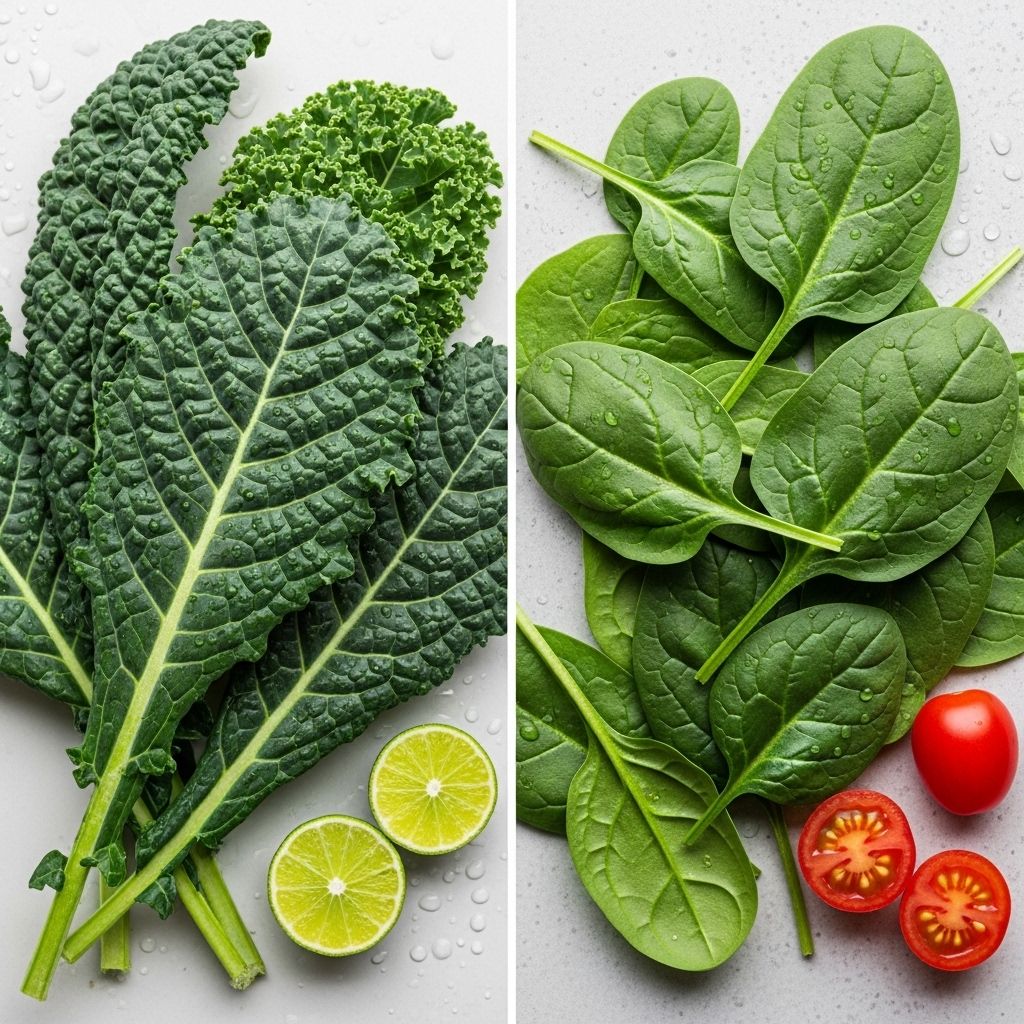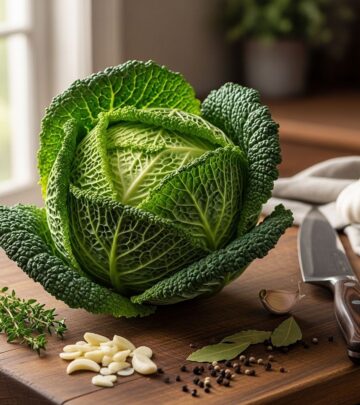Kale vs. Spinach: Nutrition, Health Benefits, and Key Differences
Unique compounds support bone, eye, and immune wellness in every leafy bite.

Kale vs. Spinach: Ultimate Nutrition and Health Guide
Kale and spinach are two of the most popular leafy greens embraced in diets across the globe. Both are packed with vitamins, minerals, and antioxidants that support overall health and wellness. But is one really healthier than the other, or do their unique properties serve different health needs? Here, we break down the nutritional comparison, health benefits, risks, and ways to include these nutrient-dense veggies in your meals.
Classification and Appearance
Though kale and spinach are both leafy greens, they belong to different plant families and have distinct appearances.
- Kale is a member of the Brassica family, which includes broccoli, cauliflower, and Brussels sprouts. Kale leaves are usually darker, bluish-green or even purplish, and feature curly or frilly edges with a sturdy central rib.
- Spinach belongs to the Amaranthaceae family, which includes beets and chard. Its leaves are vibrant green, oval or heart-shaped, and much thinner and more delicate than kale’s leaves.
Taste and Culinary Use
- Kale has a robust, earthy, and slightly bitter flavor with a firm, fibrous texture. Cooking or massaging kale can make the leaves more tender and mellow the bitterness.
- Spinach is mild and sweet, offering a softer texture that works well raw or cooked.
- Both greens are versatile: spinach stars in salads, sandwiches, and smoothies, while kale is often added to soups, stews, stir-fries, and chips.
Nutrition Comparison
Both kale and spinach provide significant health benefits. Below is a breakdown per 100g serving and 1 cup raw, for clarity.
| 100g Boiled Kale | 100g Boiled Spinach | |
|---|---|---|
| Calories | 28 | 23 |
| Carbohydrates | 5.63g | 3.75g |
| Dietary Fiber | ~3g | ~3.4g |
| Protein | 2g | 3g |
| Fat | <1g | <1g |
| Sugar | Higher | Lower |
Micronutrient Highlights (Per 1 Cup Raw)
| Nutrient | Kale | Spinach |
|---|---|---|
| Vitamin K | 68% RDI | 121% RDI |
| Vitamin C | 22% RDI | 9% RDI |
| Vitamin A | 6% RDI | 16% RDI |
| Calcium | 4% RDI | 2% RDI |
| Folate | 3% RDI | 15% RDI |
| Magnesium | 2% RDI | 6% RDI |
| Iron | 2% RDI | 5% RDI |
| Potassium | 2% RDI | 4% RDI |
Key takeaways:
- Kale: Higher in vitamin C and calcium.
- Spinach: Higher in vitamin K, vitamin A, folate, magnesium, iron, and potassium.
- Protein is slightly higher in spinach, while kale has more sugar and net carbs.
Unique Nutrients and Plant Compounds
- Kale contains key phytochemicals such as zeaxanthin and lutein, crucial for eye health and may reduce risk of certain types of blindness.
- Spinach contains oxalates (66x more than kale), which in high amounts may increase risk of kidney stone formation.
- Both greens are rich in antioxidants like beta-carotene and vitamin E, protecting cells from oxidative stress.
Health Benefits
Kale Health Benefits
- Bone Health: Rich in vitamin K and calcium, kale supports bone formation and healthy clotting.
- Immune Support: High vitamin C content boosts immune response and protects against common illnesses.
- Eye Health: Contains lutein and zeaxanthin, protecting eyes from damage and supporting vision.
- Heart Health: May support healthy cholesterol levels and lower risk of cardiovascular disease due to fiber and compounds found in Brassica family vegetables.
Spinach Health Benefits
- Iron and Blood Health: Spinach is a potent source of iron and folate, necessary for red blood cell formation and preventing anemia.
- Vision Support: Beta-carotene aids in healthy eyesight, and magnesium helps muscle and nerve function.
- Bone Strength: Higher vitamin K content per cup compared to kale, also rich in minerals like potassium and magnesium for bone health.
- Digestive Wellness: Slightly higher dietary fiber content supports healthy digestion.
Potential Risks and Considerations
- Spinach: Very high oxalate content. People at risk of kidney stones may need to limit intake.
- Kale: Contains goitrogens, which could impact thyroid function if consumed excessively. Cooking reduces this risk.
- Both vegetables should be washed thoroughly to remove pesticides.
- Steaming or blanching can reduce antinutrient content and increase mineral absorption.
Versatility and Cooking Tips
Best Ways to Use Kale
- Sautéed with garlic and olive oil
- Baked in the oven for crispy kale chips
- Added to hearty soups and stews
- Used as a sturdy base in salads, massaged to tenderize
- Blended into smoothies for a nutrition boost
Best Ways to Use Spinach
- Raw in salads and sandwiches
- Quickly wilted into hot pasta or stir-fries
- Blended into green smoothies
- Baked into quiches, frittatas, or savory pastries
- Added to omelets or alongside scrambled eggs
Which Green Should You Choose?
The best choice depends on your nutritional needs and preferences. If you want extra vitamin C and calcium, choose kale. If you’re seeking more iron, folate, or magnesium (especially important for pregnant women or those with anemia), spinach is ideal. Both are low-calorie, fiber-rich, and support heart, bone, and eye health—making either a win for a healthy diet.
Frequently Asked Questions (FAQs)
Q: Is kale better than spinach?
A: Both are highly nutritious and valuable in a healthy diet. Kale offers more vitamin C and calcium, while spinach contains more iron, folate, and magnesium. Personal dietary needs determine which is better.
Q: Can I substitute spinach for kale in recipes?
A: Yes, you can substitute spinach for kale in most recipes. Keep in mind the texture and cooking times differ; spinach wilts faster and is milder, while kale needs more cooking or massaging to soften.
Q: Are there any risks in eating too much kale or spinach?
A: Excessive spinach intake may increase risk of kidney stones due to high oxalate levels. Too much raw kale can impact thyroid function in sensitive individuals, but cooking helps reduce goitrogens.
Q: What is the best way to eat kale and spinach for maximum nutrition?
A: Both can be enjoyed raw or cooked. Light steaming or sautéing can help boost nutrient absorption and reduce antinutrients. Pairing with a healthy fat source (like olive oil or avocado) helps with absorption of fat-soluble vitamins.
Q: Can both kale and spinach be consumed daily?
A: Yes, most people can safely enjoy both greens daily as part of a balanced diet, unless advised otherwise by a healthcare provider based on health status.
Quick Comparison Table
| Aspect | Kale | Spinach |
|---|---|---|
| Family | Brassica | Amaranthaceae |
| Color | Darker, bluish-green/purple | Bright green |
| Texture | Fibrous, curly | Softer, delicate |
| Taste | Bitter, earthy | Mild, sweet |
| Vitamin C | Higher | Lower |
| Vitamin K | High | Higher |
| Iron | Moderate | Higher |
| Calcium | Higher | Lower |
| Oxalates | Low | High |
| Antioxidants | Lutein, zeaxanthin | Beta-carotene |
| Best for | Immunity, bones, heart, eyes | Blood, bones, digestion, vision |
Final Thoughts
Kale and spinach both earn their status as superfoods. Including a mix of leafy greens in your diet can maximize your nutritional benefits and add variety to meals. The choice between kale and spinach ultimately boils down to your personal health goals and taste preferences. Whichever you choose, you’re making a powerful choice for better health.
References
- https://foodstruct.com/nutrition-comparison-text/spinach-vs-kale
- https://www.healthline.com/nutrition/kale-vs-spinach
- https://www.medicalnewstoday.com/articles/kale-vs-spinach
- https://health.clevelandclinic.org/kale-vs-spinach-which-is-heart-healthier
- https://kyla.com/p/blog/kale-vs-spinach/
- https://www.healthcastle.com/nutrition-faceoff-kale-vs-spinach/
Read full bio of Sneha Tete












